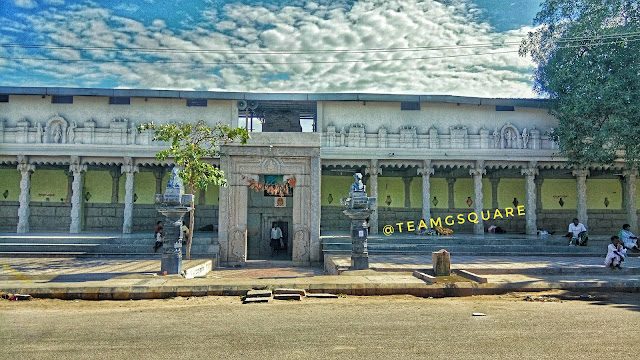Last time around, I had the opportunity to explore this small yet very beautiful temple near Sringeri, dedicated to Neelakanteshwara swami. About 2 km from Hariharapura is Jammatige, a small village located on the banks of the river Tunga. Jammatige is home to a very beautiful temple dedicated to Lord Neelakanteshwara, a form of Bhagwan Shiva. This
temple was built in 1654 CE as per the Indian calendar year (or 1732 CE as per the English calendar). The credit of building this temple goes to Kallanna, s/o Kolluranna of Kalasa, as per the inscriptions found here on the temple base
(Adhisthana). A paper inscription dated 1774 regarding donations to this temple by Sri K H Rudraiyya of Holalakere was published by Dr. B
Rajashekarappa. The temple authorities also have records of damages occurred to the temple due to floods from river Tunga in the 20th century and details of the restoration activity. Sri Neelakanteshwara temple is
built in typical Keladi style, devoid of Navaranga and comprising only the Garbhagriha,
Antarala, Mukhamantapa and Prakara, the outer wall that encloses the temple sanctum. The walls of this temple are adorned with carvings from
various epics, puranas and scenes from daily lives of people.
 |
| Sri Neelakanteshwara Temple, Jammatige |
 |
| Shikhara |
 |
| Details of Inscriptions found here |
 |
| Sri Neelakanteshwara Swamy |
It was quite intriguing to witness Lord Ganesha atop his vahana, seated on an elephant howdah on one side and Goddess Durga on the other side, guarding the temple as dwarapalas of the garbhagriha.
 |
| Door Frame of Garbhagriha |
 |
| Lord Ganesha seated on his Vahana on Elephant's Back |
There are 2 friezes on the lintel of the Garbhagriha door -
the top frieze carries carvings of Dwadasha (12) Jyothirlingas with a Nandi and the bottom
frieze comprises of carvings depicting the story of sage Valmiki along with the Saptharishis in
Brahmaloka.
 |
| Friezes of the Lintel depicting Dwadasha Jyothirlingas and Valmiki Kathe |
The inner walls of the Antarala are decorated with many
interesting and unique carvings.
1. A beautiful carving of Dashabhuja Chandra deva on a
chariot run by 10 horses (Dashashwa ratha) and next to this is a carving of Brahma
deva along with Saraswathi Devi seated on a peacock.
 |
| Chandra Deva |
2. Carving of Chaturbhuja Surya deva on a chariot run
by 7 horses with Aruna as his charioteer depicted with Mandeha, an asura
who troubled Surya deva daily at dusk. Read more about it here.
 |
| Surya Deva and his Chariot |
3. A unique depiction of Lord Anjaneya and
his son Makaradhwaja
 |
| Lord Anjaneya and Makaradhwaja |
4. One more beautiful and unique depiction of Sapthaloka
(Svarloka, Satyaloka, Tapoloka, Janaloka, Mahaloka, Bhuvarloka, Bhuloka) – 7 upper realms on Asthadiggajja (Airavatha, Pundareeka, Vamana,
Kumuda, Anjana, Pusphadanta, Sarwabhouma, Suprateeka – 8 elephants holding eight cardinal
directions of the world) supported by Adishesha and who in turn is seated on
Kuruma.
 |
| Sapthaloka |
5. Carving of Panchamukhi Brahma seated on a chariot.
 |
| Panchamukhi Brahma Deva with Chariot |
6. Gopalakrishna swami
 |
| Venugopala Swami |
7. Garuda Deva
 |
| Garuda Deva |
The front outer wall of the Antarala carries a beautiful depiction of the beginning and ending of Kaliyuga along with
the Shaiva Dwarapalas.
 |
| Beginning of Kaliyuga (when lust wins over righteousness) |
 |
| End of Kaliyuga (when humans start eating other humans) |
The outer walls of the temples are adorned with carvings of the Dashavatara, Ramayana Katha, Bhagwat Purana, Mahabharata, Kailasaloka, Yamaloka and Naraka.
 |
| Ramayana Friezes |
 |
| Friezes Depicting Hell, Punishment in Hell and Story of River Ganga |
 |
| Kailasha and Yama Loka |
 |
| Mahabharata Friezes |
 |
| Asuraraja Ravana |
 |
| Tripura Samhara Shiva |
 |
| Ugra Narasimha Swami |
 |
| Shanmuga Swami |
References: 2. Chikkamagaluru Jilleya Itihasa Mathu Puratatva (Book by GoK)
Related Posts:






















































